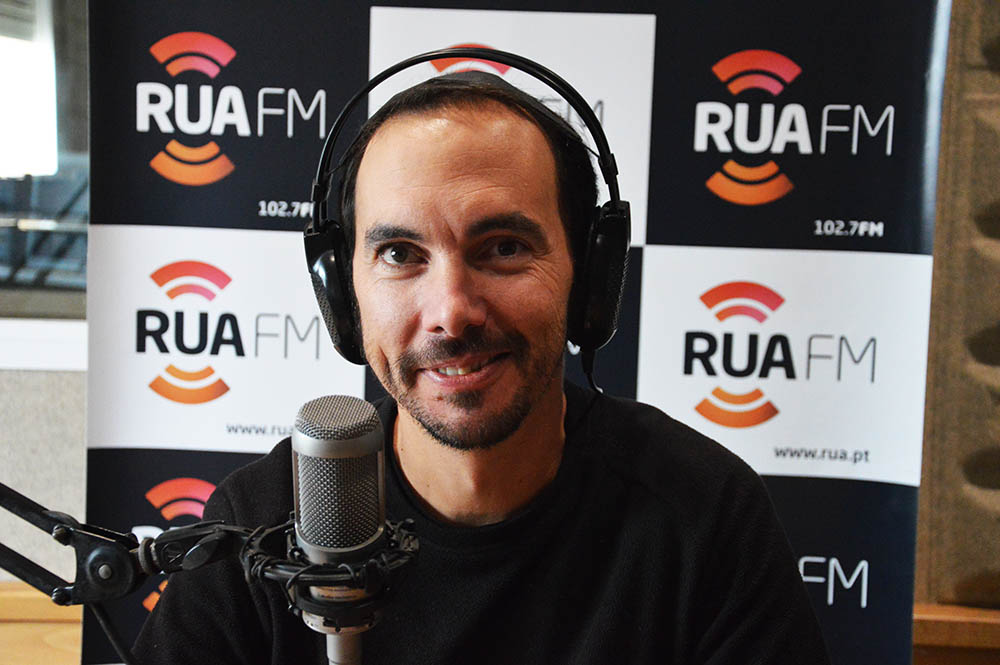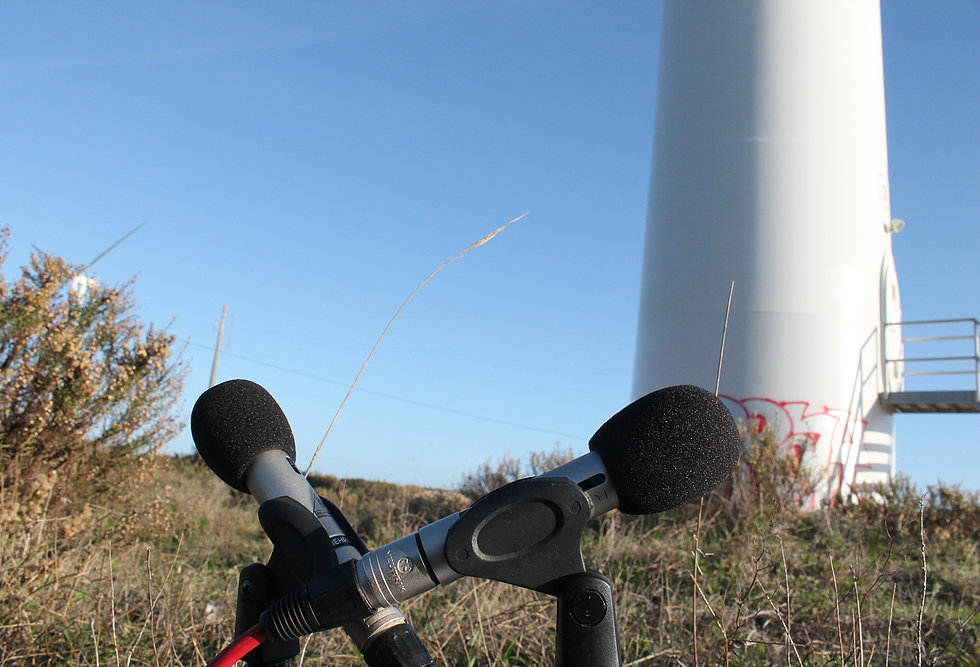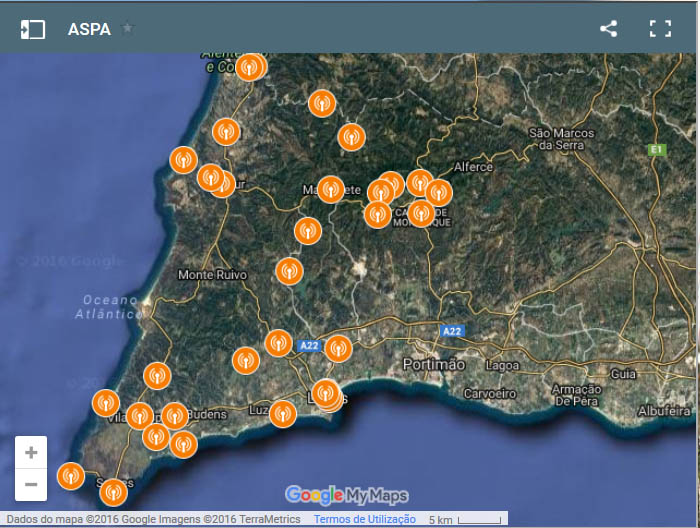 The sound of Monte Clérigo beach on a busy summer day, the rustle of the blades of the Gruta Funda Wind Farm, the thunderous noise of a storm at the Fonte Santa viewpoint, on the way to Fóia. These are just three of the 130 different sounds recorded over the months by Carlos Norton, founder of the recently created cultural association Fungo Azul and sound designer, within the scope of the ASPA project – Sound Archive Landscape of the Algarve.
The sound of Monte Clérigo beach on a busy summer day, the rustle of the blades of the Gruta Funda Wind Farm, the thunderous noise of a storm at the Fonte Santa viewpoint, on the way to Fóia. These are just three of the 130 different sounds recorded over the months by Carlos Norton, founder of the recently created cultural association Fungo Azul and sound designer, within the scope of the ASPA project – Sound Archive Landscape of the Algarve.
The ASPA saw, on December 21st, the light of day, with the availability, on an interactive map on the internet, accessible to all, from a first batch of 33 sound collections, in the municipalities of Aljezur, Vila do Bispo, Lagos and Monchique.
The objective of this project, which was financially supported by the Regional Directorate of Culture of the Algarve, is «to create a sound database of the Algarve», explained Carlos Norton, in an interview with the «Impressões» program, jointly produced by Sul Informação and Algarve University Radio (RUA FM).
The initial idea was born when Norton was in England doing a PhD in his area of training (Marine Biology) and he missed Faro: "and if there was one thing I missed it was being on a pier on the edge of the Ria Formosa, reading a book, listening to the calm waters of the ria".
And that's when it occurred to him that, «if I could be here in England, in the middle of this rain and fog, and I could be listening to the sound of the Ria Formosa and reading a book, it would be phenomenal». And so Fungo Azul was born and its project to create the so-called Landscape Sound Archive of the Algarve.
Firstly, Norton explains, this collection is intended for «those who are abroad and miss the Algarve». As a musician and sound designer, he argues that “an image or a video is one thing, sound is something else! If we close our eyes with headphones in our heads and listen to the sound of our land, it's fantastic!”
That was how the foundations of the ASPA were born, which «later became a more scientific project of exhaustive collection of the entire Algarve, because the landscape sound is also intangible heritage, it is something that is changeable. The sound of an 80s city has nothing to do with the sound of today and has nothing to do with what it will be 20 years from now. It is something that can and should be collected for study and to document and remember», he says.
But there is also a third and important function, which is «to make known to those who do not know the Algarve», but from the angle of sound. «Those who come to visit, those who are considering moving to the Algarve, will do research on the internet and see photographs and videos. But now you can hear how the Levante Market in Lagos is or how the sound of a beach is”, which “will give you a complete idea of what it will be like to arrive in the Algarve”.
Carlos Norton stresses that «in the XNUMXst century, we live in a time when the image rules, only the eyes work, the ears are accessories». But here, at ASPA, this is not the case, it is rather “returning to the essence of sound as a primordial sense”.
 Over the months in which he walked all over the Algarve, microphones and recorder in hand, the sound designer noticed interesting things. For example, “noise is a constant, especially car noise. It's amazing how, while recording on a beach or in the middle of an isolated mountain range, the noise of cars is always there, always. We haven't even heard…»
Over the months in which he walked all over the Algarve, microphones and recorder in hand, the sound designer noticed interesting things. For example, “noise is a constant, especially car noise. It's amazing how, while recording on a beach or in the middle of an isolated mountain range, the noise of cars is always there, always. We haven't even heard…»
Sound collection is done with two microphones, in a stereo environment, and the microphones are arranged in a way that mimics the human ear. Therefore, he advises, "when you hear the collection, listen with a good sound system or with headphones in your head because it will recreate being sitting in the place, listening to it".
Carlos Norton guarantees that «walking through the Algarve with microphones was a fabulous experience».
And which sound impressed you the most? “There are some that I particularly like, for example, the recording that was made on Monte Clérigo beach. I was lying on the towel, I had taken the equipment that I always carry with me and I started recording the sound. In other words, it is not the beautiful sound of the sea and seagulls. Not! It's the noise of someone sitting in the middle of the beach. You can hear people, the sea in the background, children screaming around and playing ball, that banal sound».
But «there is a particular sound that I love, and that I think you should hear, which is the sound collected in Vila do Bispo, at the Gruta Funda Wind Farm, and in which the sound was captured right under the blades of the windmill turning . And that makes a phenomenal sound», he says, excited.
In his work of collecting, Norton tries to be "as discreet as possible, so that there is no interference". Because, he explains, there is a premise in ASPA: «the sound collection is always done in a genuine and unique way, that is, I arrive at a place, put the microphones to record and record for 15 minutes and it's done, regardless of the let it happen!”
The collections were carried out throughout the Algarve, having been «an equitable distribution of the municipalities», but there were also collections that were not scheduled. Norton recalls that «one of the collections was made in the Monchique mountains, at the Fonte Santa viewpoint, next to Fóia, simply because I arrived home – and I live next to Fóia – and there was a horrible storm, a beautiful thunderstorm. What did I do? I took the microphone, got into the car and went upstairs to record it. It was a horrible rain. I recorded inside the car, the umbrella outside, and that sound of thunder and rain hitting the umbrella is collected. That sound is collected, it was a moment that I wanted to collect».
But there were also other, more complicated situations, one that left the sound designer with “ethical problems”: fires.
«Where I live I spent a week trying to figure out if it was going to burn or not and [the fire] stayed right there at the door and my first impulse was: I'm going to grab the material and I'm going to record the sound of the fire. And it's a question that can still be asked today: should I have gone or shouldn't I have gone? I hesitated a lot at the time, almost with that reporter's feeling of wanting to record everything. The fire is something that exists, and it has a very characteristic sound and it would be beautiful, in terms of sound design, if it were recorded. But, for ethical reasons, I couldn't. It was very easy, but it would be almost outrageous for the people who were suffering from the fire for me to be there, graceful, microphone in hand, taking advantage of an alien and community misfortune. Above all, I was worried about the fire, because I walked there with a hoe in my hand, helping the firefighters to put out the fire and I thought it was more useful to do this work».
The ASPA ends here, with the availability of these first 130 collections throughout the Algarve, or is it a project to continue? And, in a few years' time, Norton will return to collecting sound in the same places?
The sound designer answers that “this is one of the ideas”. Bearing in mind that the collection was carried out in a scientific way, “there is a field notebook in which everything is pointed out – from the cloudiness, the wind, to the position of the microphones. A photograph of the material is taken, and for what? So that, 20 years from now, if we want to go to the same place, we can put the microphones in exactly the same place and the collection will be a perfect replica».
Bearing in mind that what he's been doing is collecting soundscapes throughout the Algarve, there have been some "accidents on the way", which end up being part of the project. «Travel accidents that are natural, I'm there recording and I'm part of the landscape. I remember when I went to record at Aljezur Castle, which is a very quiet place, few visitors get there and usually go up on foot. And I arrive there with the material, I stand at the door of the cistern, and when I start recording, three cars arrive and for seven minutes the visitors are there screaming. But I thought: this is part of the landscape. There are times when we arrive at the castle and there is this landscape, others not. This is the hardest part, realizing that this is the natural landscape, because the sound is never the same. I can go to the castle five times and always pick up different things and none of them are fake. As it is not false that I am recording».
On the other hand, “sometimes there are small interferences with me. Once, I was recording in the center of Marmelete, in the municipality of Monchique, I discreetly put the microphones on, and then I hear a door open and I hear: Good afternoon! And now what do I do? I won't be rude, I'm here, I have to say: Good afternoon! This is part of the recording. These are things that happen, they are natural things, and it is also for posterity».
The ASPA – Algarve's Landscape Sound Archive began last April, with a phase of study and prospection for the best locations, through the observation of satellite images. Then, between May and July, extensive visits were made to the land, to choose the places to collect ambient sound.
Since August, Fungo Azul has been making collections, in files lasting exactly 15 minutes. For logistical reasons, due to the low budget for this initiative, the decision was taken to phase the collections, creating four sectors: Sector EO, which includes the municipalities of Aljezur, Vila do Bispo, Lagos and Monchique, Sector CO, with Portimão, Lagoa, Silves and Albufeira, the CE Sector, with Loulé, Faro, Olhão and São Brás, and also the EE Sector, with Tavira, Castro Marim, VRSA and Alcoutim.
In the region's total, there are 130 collections spread across all municipalities. The EO sector, the first to be made available on the internet, on the interactive map created for this purpose, on the 21st of December, it has 33 collections. "The 1st sector was launched on December 21st, the second will be on January 21st, then March and April, always on the 21st", reveals Carlos Norton.
«Initially we had planned to make about 300 recordings, but it was not possible, we will have, at the conclusion of this first phase, at 130, in which there will be 30 to 35 for each sector». But this is an archive that will be built for many, many years, the ASPA will not end now, it will continue in 2017. «At the launch of the last sector, there will be a small event to conclude the project, in this first phase», he announces .
There are many plans: «it is planned, in some time, to open the collections to the community. We want the people themselves, who have material, who are willing, if necessary with a mobile phone, to make their own recordings to include on the map».
The “raw, genuine sound, as it is” collected over the months of work will now be made available in two ways: on the one hand through the interactive map, which has a player to listen to the sound. But, being an artist himself, Carlos Norton reveals that «there is also the possibility of making available the raw sound. We even invite artists who want to make plastic or sound works, on top of the collections, who can do so, and we provide the original files».
To carry out all this work, the support of the Regional Directorate of Culture of the Algarve was essential, which «allowed the study phase, the first recordings and the creation of the interactive map, where we make everything available». But now «that's over», but the members of the Fungo Azul association want to continue with the ASPA, so, promises Carlos Norton, «we'll come back to compete to make this archive grow». And it may be that, after the first results of this original collection of soundscapes from a region are known, other entities interested in supporting the ASPA will emerge.
“It is not very easy to get funding for this type of project, because there is always a preference for concrete things. It can be a festival, it can be a concert, it can be an edition, and this is an oddity, something that is not palpable, that is not of immediate interest to most people", but which "is very important to the future".
So you already know: when you want to hear the Algarve (or the many Algarves), just click here.
Listen to Carlos Norton's interview to the program «Impressions» of RUA FM in full



















Comments